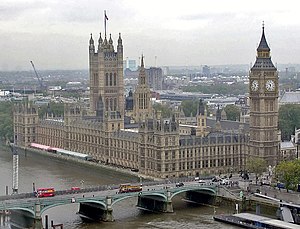Britain
The Times
Stone table of royal power lunch found in seat of democracy
By Lewis Smith

A section of the King's Table, which was buried beneath Westminster Hall after the Restoration (MUSEUM OF LONDON)
SECTIONS of the King’s Table, a symbol of royal power until it was smashed by Oliver Cromwell, have been found beneath the floor of the Palace of Westminster.
The elaborately carved stone table was used by kings and queens from the 13th century for coronation feasts and state banquets but disappeared under Puritan rule.
It represented the power and authority of the monarch in the same way as the King’s Bench, a court, and the King’s Privy Wardrobe, also known as the Jewel Tower.
A new table was made in the 17th century after the Restoration but the original remained missing. Archaeologists have now found large sections of at least four of the arched marble trestles that supported the tabletop, which they calculate to have been about 19ft long.

The "Mother of Parliaments" - Palace of Westminster
They were buried beneath the floor of Westminster Hall, apparently as a symbol of the return of royal power after the fall of the Commonwealth. When Cromwell came to power the table was removed from the Palace and broken up to mark the destruction of the monarchy.
The discovery of several pieces in excavations this year, reported in British Archaeology magazine today, confirms a theory that during the Restoration the remains of the table were retrieved. Archaeologists hope to put the pieces on display in Westminster Hall. The broken pieces were placed in the foundations of a dais built in the 17th century in Westminster Hall, which was used by James II at his coronation banquet.
Phil Emery, a consultant archaeological engineer, said: “It’s the iconic symbol of royal power. Its significance is underlined by the haste with which it was replaced at the restoration of the monarchy.
“People often ask us what’s the most exciting thing we’ve found. At last I have the unequivocal answer. It doesn’t get more significant than this.” Among the monarchs known to have sat at it are Edward I and Henry VIII. King Henry used it for feasts after his marriages to Catherine of Aragon and Anne Boleyn.
Edward I, the king who took the Stone of Scone from Scotland and was dubbed the Hammer of the Scots, is the first monarch known to have used it, but the mid 13th- century style of carving suggests that it could date back to Henry III.
In the 1960s a piece of the table was recovered from beneath the floor of Westminster Hall but until this year’s finds it could not be confirmed whether the fragment had been placed there intentionally.
Chris Thomas, of the Museum of London, said that the find was also important because of the rarity of stone furniture surviving for more than 700 years. “You get altars in churches but that’s about it,” he said.
thetimesonline.co.uk
The Times
Stone table of royal power lunch found in seat of democracy
By Lewis Smith

A section of the King's Table, which was buried beneath Westminster Hall after the Restoration (MUSEUM OF LONDON)
SECTIONS of the King’s Table, a symbol of royal power until it was smashed by Oliver Cromwell, have been found beneath the floor of the Palace of Westminster.
The elaborately carved stone table was used by kings and queens from the 13th century for coronation feasts and state banquets but disappeared under Puritan rule.
It represented the power and authority of the monarch in the same way as the King’s Bench, a court, and the King’s Privy Wardrobe, also known as the Jewel Tower.
A new table was made in the 17th century after the Restoration but the original remained missing. Archaeologists have now found large sections of at least four of the arched marble trestles that supported the tabletop, which they calculate to have been about 19ft long.

The "Mother of Parliaments" - Palace of Westminster
They were buried beneath the floor of Westminster Hall, apparently as a symbol of the return of royal power after the fall of the Commonwealth. When Cromwell came to power the table was removed from the Palace and broken up to mark the destruction of the monarchy.
The discovery of several pieces in excavations this year, reported in British Archaeology magazine today, confirms a theory that during the Restoration the remains of the table were retrieved. Archaeologists hope to put the pieces on display in Westminster Hall. The broken pieces were placed in the foundations of a dais built in the 17th century in Westminster Hall, which was used by James II at his coronation banquet.
Phil Emery, a consultant archaeological engineer, said: “It’s the iconic symbol of royal power. Its significance is underlined by the haste with which it was replaced at the restoration of the monarchy.
“People often ask us what’s the most exciting thing we’ve found. At last I have the unequivocal answer. It doesn’t get more significant than this.” Among the monarchs known to have sat at it are Edward I and Henry VIII. King Henry used it for feasts after his marriages to Catherine of Aragon and Anne Boleyn.
Edward I, the king who took the Stone of Scone from Scotland and was dubbed the Hammer of the Scots, is the first monarch known to have used it, but the mid 13th- century style of carving suggests that it could date back to Henry III.
In the 1960s a piece of the table was recovered from beneath the floor of Westminster Hall but until this year’s finds it could not be confirmed whether the fragment had been placed there intentionally.
Chris Thomas, of the Museum of London, said that the find was also important because of the rarity of stone furniture surviving for more than 700 years. “You get altars in churches but that’s about it,” he said.
thetimesonline.co.uk